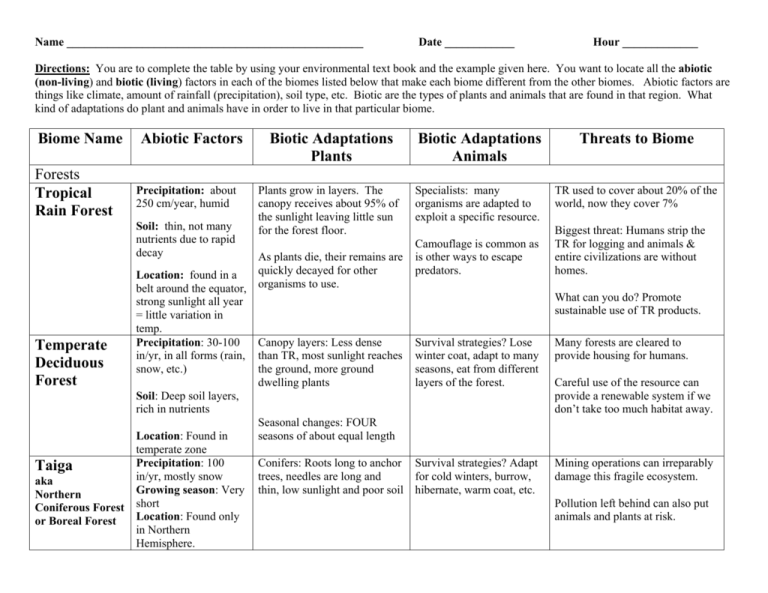The Most Important Abiotic Factors When Studying Biomes Are
Water H 2 O is a very important abiotic factor it is often said that water is life. Which type of tree is found in temperate forest.

An Introduction To Ecology And The Biosphere Ppt Download
Even though freshwater biome constitutes mere 008 percent of the vast aquatic biome it does play a crucial role in facilitating the existence of life on planet Earth.

. These factors sometimes determine whether a species can live in a place in a very direct way. Home Uncategorized the most important abiotic factors when studying biomes are. Sometimes drought-tolerant and fireresistant trees or shrubs.
The most important abiotic factors include water sunlight oxygen soil and temperature. 7 What are the biotic interactions in an ecosystem. The most important abiotic factor when studying biomes are.
Which three abiotic factors studied in this lab are the most important in the development and global distribution of biomes. Abiotic factors that influence aquatic biomes include light availability depth stratification temperature currents and tides. Mono lake contains 280 million tons of.
Water H2O is a very important abiotic factor it is often said that water is life All living organisms need water. Examples of Abiotic Factors Wind. Some examples of abiotic factors in aquatic ecosystems include light salinity oxygen content rate of.
In fact water makes up at least 50 of almost all living things. 6 Why biotic and abiotic is important in an ecosystem. Water and Temperature.
Abiotic factor means the non living chemical or physical parts of the ecosystem. The most important abiotic factors include water sunlight oxygen soil and temperature. Abiotic factors are especially important.
For instance a plant species will only take root and spread in a place where its getting enough sunlight and water. The abiotic factors will define which organisms are able or not to live in a specified place. Water H2O is a very important abiotic factor it is often said that water is life All living organisms need water.
Nonliving parts of an ecosystem. A nonliving component of an ecosystem such as air water light minerals or temperature. Venus Fly Traps are a key point to be able to help to keep the insect population lower.
It has hot humid summers. Abiotic factors in aquatic ecosystems refer to any non-living component of an ecosystem. The most important abiotic factors include water sunlight oxygen soil and temperature.
11 How do abiotic factors affect coral reefs. Temperate grasslands savannas and shrublands is a terrestrial biome defined by the World Wide Fund for Nature. Biotic factors include plants animals and microbes.
Biotic and Abiotic factors The most important Abiotic factor in Mono Lake is the high contents of salt water. Salinity the concentration of salt in water. How abiotic factors determine biotic factors.
It is important to study the abioitc factors of the freshwater biome and their influence on plants and animals if you are to get well-versed with the biodiversity of this biome. So considering that only water and temperature are the abiotic components out of all the given options. 8 How does abiotic contribute to an ecosystem.
How are abiotic factors affected. Frequent fires set by lightning Dominant plants. What are the abiotic factors in an aquatic biome.
Examples of abiotic factors include the supply of energy and. Posted less then minute ago by in Uncategorized 0. What is the most important ABIOTIC factor of the temperate deciduous forest.
It has nutrient-poor soil. The most important abiotic factors when studying biomes are. The tundra biome the desert biome are both very dry but.
Examples of important abiotic factors include temperature sunlight and moisture level. Examples of abiotic factors include sunlight water air humidity pH temperature salinity precipitation altitude type of soil minerals wind dissolved oxygen mineral nutrients present in the soil air and water etc. The most important abiotic factors include water sunlight oxygen soil and temperature.
Biotic factors depend on abiotic factors for survival and reproduction. Water H2O is a very important abiotic factor it is often said that water is life All living organisms need water. Important abiotic factors include the amount of sunlight in the ecosystem the amount of oxygen and nutrients dissolved in the water proximity to land depth and temperature.
10 How do abiotic factors affect biotic factors in the ocean. The most important abiotic factor in any ecosystem is ____________. 9 Why is it that biotic and abiotic components are interrelated to each other.
They can help determine things like how tall trees grow where animals and plants are found and why birds migrate. Since pond is the ecosytem here water is the most important abiotic factor because pond is essentially made of up water. Abiotic factors include water sunlight oxygen soil and temperature.
What are the abiotic factors in your biome. Both biotic and abiotic factors are related to each other in an ecosystem and if one factor is changed or removed it can affect the entire ecosystem. Living organisms in an ecosystem.
Animals plants and microrganims. Sunlight is one the most important abiotic factors for marine ecosystems. Temperature and precipitation and variations in both are key abiotic factors that shape the composition of animal and plant communities in terrestrial biomes.
The most important abiotic factors when studying biomes are. What Are 10 Abiotic Factors In A Biome. Some biomes such as temperate grasslands.
Abiotic factors are the non-living parts of the environment that have a major influence on living organisms.
What Are The Two Main Types Of Biomes And Four Important Abiotic Factors That Affect The Kinds Of Organisms That Live In Them Socratic

Biome Name Abiotic Factors Biotic Adaptations Plants Biotic

Introduction To Ecology Biotic And Abiotic Factors Ppt Download
No comments for "The Most Important Abiotic Factors When Studying Biomes Are"
Post a Comment